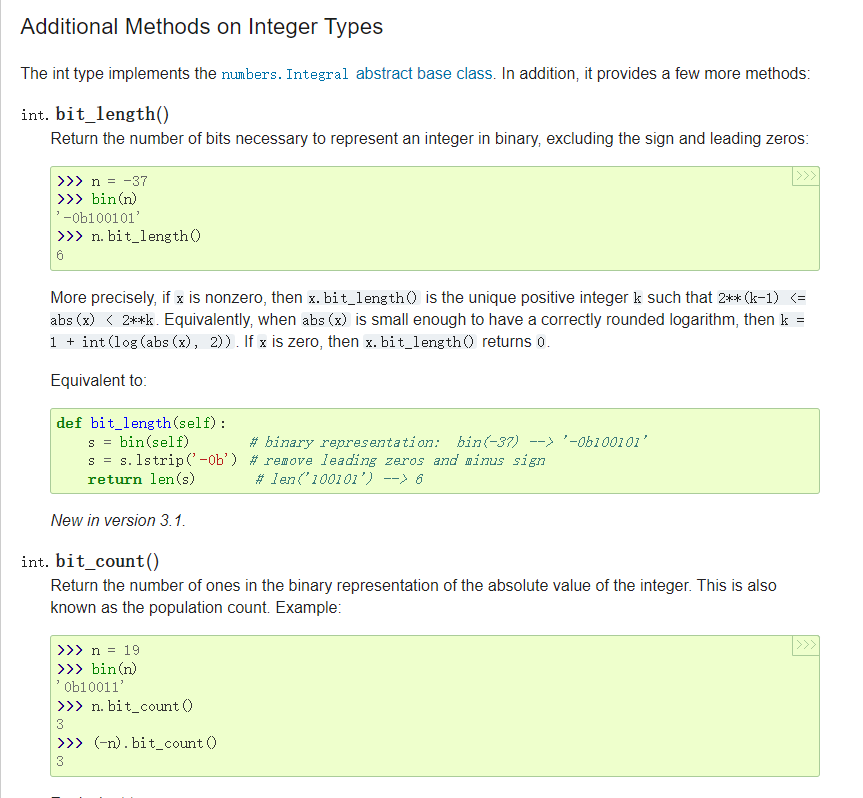![[译] 关于 Python 中的数字你可能不知道的 3 件事_层次结构](http://img.558idc.com/uploadfile/allimg/python/48af68618439add97699125f5b3924bab4cce4.jpg)
如果您使用 Python 进行过任何编码,那么您很有可能在某个程序中使用了数字。例如,您可能使用整数来指定列表中值的索引。 但是 Python 中的数字不仅仅是它们的原始值。让我们看看你可能不知道的关于 Python 中数字的三件事。
1. 数字有方法
Python 中有个概念叫做:一切皆对象。您在 Python 中学习的第一个对象 "HelloWorld" 是表示字符串的 str 对象。
然后你学习了字符串有方法,例如 .lower() 方法,它返回一个全小写字符的新字符串:
'hello'
比如首字母大写 capitalize(), 返回字符串的副本,其第一个字符大写,其余小写。
>>> print(mystring.capitalize())
Hello python
Python 中的数字也是对象,就像字符串一样,也有自己的方法。例如,您可以使用 .to_bytes() 方法:
>>> n.to_bytes(length=2, byteorder="big")
b'\x00\xff'
其中,length 参数指定了要在字符串中使用的字节数,byteorder 参数确定字节的顺序。例如,将 byteorder 设置为 “big”会返回一个字节字符串,其中最重要的字节在前,而将 byteorder 设置为 "little" 则将最不重要的字节放在最前面。
b'\xff\x00'
255 是可以表示为 8 位整数的最大整数,因此您可以在 .to_bytes() 中设置 length=1 也没有问题:
b'\xff'
但是,如果在 .to_bytes() 中将 length=1 设置为 256,则会收到 OverflowError 错误:
>>> n.to_bytes(length=1, byteorder="big")
Traceback (most recent call last):
File "<stdin>", line 1, in <module>
OverflowError: int too big to convert
您可以使用 .from_bytes() 类方法将字节字符串转换为整数:
1729
类方法是从类名而不是类实例调用的,这就是在上面的 int 上调用 .from_bytes() 方法的原因。
浮点数也有方法。也许对浮点数最有用的方法是 .is_integer() ,它用于检查浮点数是否没有小数部分:
>>> n.is_integer()
True
>>> n = 3.14
>>> n.is_integer()
False
一种有趣的浮点方法是 .as_integer_ratio() 方法,它返回一个元组,其中包含表示浮点值的分数的分子和分母:
>>> n.as_integer_ratio()
(3, 4)
但是,由于浮点表示错误,此方法可能会返回一些意外值:
>>> n.as_integer_ratio()
(3602879701896397, 36028797018963968)
如果需要,您可以通过用括号括住文字来调用数字类型上的方法:
>>> (255).to_bytes(length=1, byteorder="big")b'\xff'
>>> (3.14).is_integer()
False
如果你没有用括号括起整数文字,当你调用一个方法时你会看到一个 SyntaxError ——尽管奇怪的是,你不需要带有浮点文字的括号:
File "<stdin>", line 1
255.to_bytes(length=1, byteorder="big")
^
SyntaxError: invalid syntax
>>> 3.14.is_integer()
False
您可以在文档中找到 Python 数字类型可用方法的完整列表:
 [译] 关于 Python 中的数字你可能不知道的 3 件事_浮点数_02](http://img.558idc.com/uploadfile/allimg/python/22225726_62b32dd687d8b63241.png)
2. 数字有层次结构
在数学中,数字具有自然的层次结构。例如,所有自然数都是整数,所有整数都是有理数,所有有理数都是实数,所有实数都是复数。 Python 中的数字也是如此。这个“数字塔”通过 numbers 模块来表示。
数字塔
Python 中的每个数字都是 Number 类的一个实例:
>>> # Integers inherit from Number
>>> isinstance(1729, Number)
True
>>> # Floats inherit from Number
>>> isinstance(3.14, Number)
True
>>> # Complex numbers inherit from Number
>>> isinstance(1j, Number)
True
如果您需要检查 Python 中的值是否为数字,但您不关心该值是什么类型的数字,请使用 isinstance(value, Number)。
Python 附带了四种额外的抽象类型,其层次结构从最通用的数字类型开始,如下所示:
你可以在你的终端中验证所有这些:
>>> import numbers>>> # Complex numbers inherit from Complex
>>> isinstance(1j, numbers.Complex)
True
>>> # Complex numbers are not Real
>>> isinstance(1j, numbers.Real)
False
>>> # Floats are Real
>>> isinstance(3.14, numbers.Real)
True
>>> # Floats are not Rational
>>> isinstance(3.14, numbers.Rational)
False
>>> # Fractions are Rational
>>> from fractions import Fraction
>>> isinstance(Fraction(1, 2), numbers.Rational)
True
>>> # Fractions are not Integral
>>> isinstance(Fraction(1, 2), numbers.Integral)
False
>>> # Ints are Integral
>>> isinstance(1729, numbers.Integral)
True
>>> # Bools are Integral
>>> isinstance(True, numbers.Integral)
True
>>> True == 1
True
>>> False == 0
True
不过,仔细看看,有几件事对 Python 的数字层次结构有些怪异。
Decimals 类型不适合上述的数字塔
Python 数字塔中的四种抽象类型对应的具体数值类型有四种:complex, float, Fraction, 和 int.
但是 Python 有第五种数字类型,即 Decimal 类,用于精确表示十进制数并克服浮点运算的限制。
你可能猜到 Decimal 数是实数,但你错了:
>>> import numbers
>>> isinstance(Decimal("3.14159"), numbers.Real)
False
事实上,Decimal 数字继承自的唯一类型是 Python 的 Number 类:
False
>>> isinstance(Decimal("3.14159"), numbers.Rational)
False
>>> isinstance(Decimal("3.14159"), numbers.Integral)
False
>>> isinstance(Decimal("3.14159"), numbers.Number)
True
Decimal 不继承自 Integral 是有道理的。在某种程度上,Decimal 不继承自 Rational 也是有道理的。但是为什么 Decimal 不从 Real 或 Complex 继承呢?
答案就在CPython 源代码中:
Decimal 具有 Real abc 指定的所有方法,但不应将其注册为 Real,因为小数不与二进制浮点数互操作(例如:*Decimal('3.14') + 2.71828* 是不支持的)。但是,抽象实数预计可以互操作(即,如果 R1 和 R2 都是实数,则 *R1 + R2* 应该可以工作)。
这一切都归结为实现。
浮点数的奇怪之处
另一方面,浮点数实现了 Real 的抽象基类,并用于表示实数。但是,由于有限的内存约束,浮点数仅仅是实数的有限近似值。这令人困惑,如以下内容:
False
浮点数作为二进制分数存储在内存中,但这会导致一些问题。 就像分数一样 1/3 没有有限的十进制表示——小数点后有无数个三。 分数 1/10 没有有限二进制分数表示。换句话说,你不能以精确的精度将 0.1 存储在计算机上——除非那台计算机有无限的内存。
从严格的数学角度来看,所有浮点数都是有理数——除了 float("inf") 和 float("nan")。但是程序员使用它们来近似实数并将它们在大多数情况下视为实数。
float("nan") 是一个特殊的浮点值,表示“非数字”值——通常缩写为 NaN 值。但是由于 float 是数字类型,所以 isinstance(float("nan"), Number) 返回 True
没错:“不是数字”值是数字。("not a number" values are numbers.)
这就是浮点数的奇怪之处。
3. 数字可扩展性
Python 的抽象数字基类型允许您创建自己的自定义抽象和具体数字类型。 即利用 Python 中关于数字的类型,比如 numbers 中的类型,可以定义其他有特殊属性和方法的数字对象。
例如,考虑下面的类 ExtendedInteger,它实现了 a+b \sqrt p 形式的数字,其中 *a* **和 *b* 是整数,p** 是素数(请注意,类不强制素数):
import numbers
class ExtendedInteger(numbers.Real):
def __init__(self, a, b, p = 2) -> None:
self.a = a
self.b = b
self.p = p
self._val = a + (b * math.sqrt(p))
def __repr__(self):
return f"{self.__class__.__name__}({self.a}, {self.b}, {self.p})"
def __str__(self):
return f"{self.a} + {self.b}√{self.p}"
def __trunc__(self):
return int(self._val)
def __float__(self):
return float(self._val)
def __hash__(self):
return hash(float(self._val))
def __floor__(self):
return math.floor(self._val)
def __ceil__(self):
return math.ceil(self._val)
def __round__(self, ndigits=None):
return round(self._val, ndigits=ndigits)
def __abs__(self):
return abs(self._val)
def __floordiv__(self, other):
return self._val // other
def __rfloordiv__(self, other):
return other // self._val
def __truediv__(self, other):
return self._val / other
def __rtruediv__(self, other):
return other / self._val
def __mod__(self, other):
return self._val % other
def __rmod__(self, other):
return other % self._val
def __lt__(self, other):
return self._val < other
def __le__(self, other):
return self._val <= other
def __eq__(self, other):
return float(self) == float(other)
def __neg__(self):
return ExtendedInteger(-self.a, -self.b, self.p)
def __pos__(self):
return ExtendedInteger(+self.a, +self.b, self.p)
def __add__(self, other):
if isinstance(other, ExtendedInteger):
# If both instances have the same p value,
# return a new ExtendedInteger instance
if self.p == other.p:
new_a = self.a + other.a
new_b = self.b + other.b
return ExtendedInteger(new_a, new_b, self.p)
# Otherwise return a float
else:
return self._val + other._val
# If other is integral, add other to self's a value
elif isinstance(other, numbers.Integral):
new_a = self.a + other
return ExtendedInteger(new_a, self.b, self.p)
# If other is real, return a float
elif isinstance(other, numbers.Real):
return self._val + other._val
# If other is of unknown type, let other determine
# what to do
else:
return NotImplemented
def __radd__(self, other):
# Addition is commutative so defer to __add__
return self.__add__(other)
def __mul__(self, other):
if isinstance(other, ExtendedInteger):
# If both instances have the same p value,
# return a new ExtendedInteger instance
if self.p == other.p:
new_a = (self.a * other.a) + (self.b * other.b * self.p)
new_b = (self.a * other.b) + (self.b * other.a)
return ExtendedInteger(new_a, new_b, self.p)
# Otherwise, return a float
else:
return self._val * other._val
# If other is integral, multiply self's a and b by other
elif isinstance(other, numbers.Integral):
new_a = self.a * other
new_b = self.b * other
return ExtendedInteger(new_a, new_b, self.p)
# If other is real, return a float
elif isinstance(other, numbers.Real):
return self._val * other
# If other is of unknown type, let other determine
# what to do
else:
return NotImplemented
def __rmul__(self, other):
# Multiplication is commutative so defer to __mul__
return self.__mul__(other)
def __pow__(self, exponent):
return self._val <strong> exponent
def __rpow__(self, base):
return base </strong> self._val
您需要实现许多 dunder方法以确保具体类型实现 Real 接口。您还必须考虑 .__add__() 和 .__mul__() 等方法如何与其他 Real 类型交互。
实现 ExtendedInteger 后,您现在可以执行以下操作:
>>> b = ExtendedInteger(2, 3)
>>> a
ExtendedInteger(1, 2, 2)
>>> # Check that a is a Number
>>> isinstance(a, numbers.Number)
True
>>> # Check that a is Real
>>> isinstance(a, numbers.Real)
True
>>> print(a)
1 + 2√2
>>> a * b
ExtendedInteger(14, 7, 2)
>>> print(a * b)
14 + 7√2
>>> float(a)
3.8284271247461903
Python 的数字层次结构非常灵活。但是,当然,在实现派生自内置抽象基类型的类型时,您应该始终非常小心。你需要确保他们与其他人相处得很好。 在实现自定义数字类型之前,您应该阅读类型实现者的文档中有几个提示。仔细阅读 Fraction 的实现也很有帮助。
总结
所以文章你看完了。关于 Python 中的数字,您可能不知道的三件事(可能还有更多):
我希望你学到了一些新东西! 参考链接:
- 3 Things You Might Not Know About Numbers in Python
- Python 中有关数字必知的三件事
